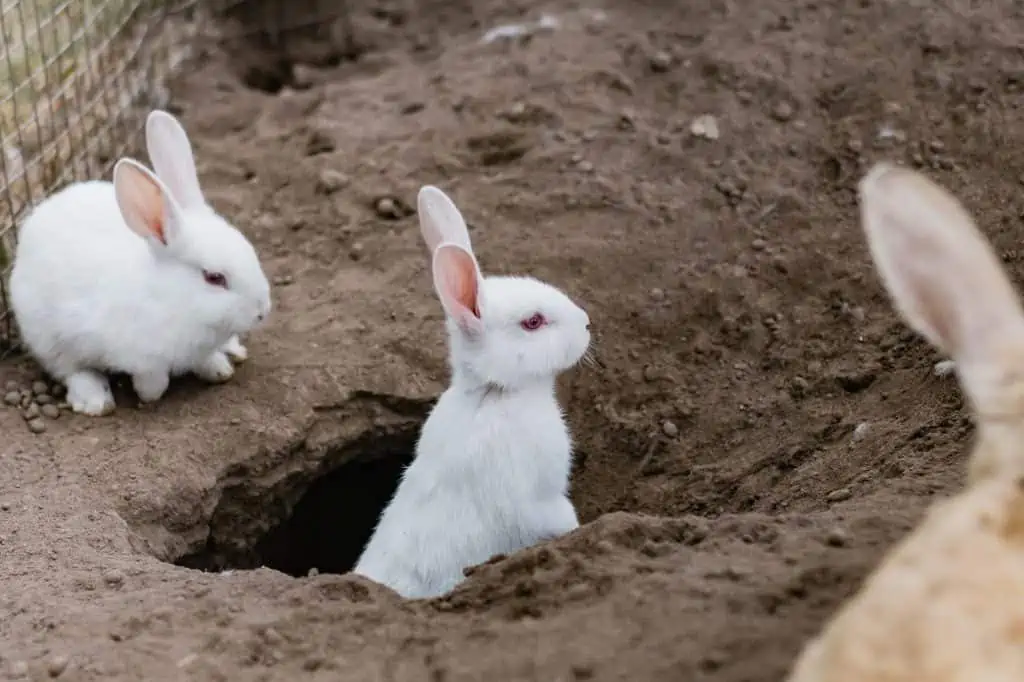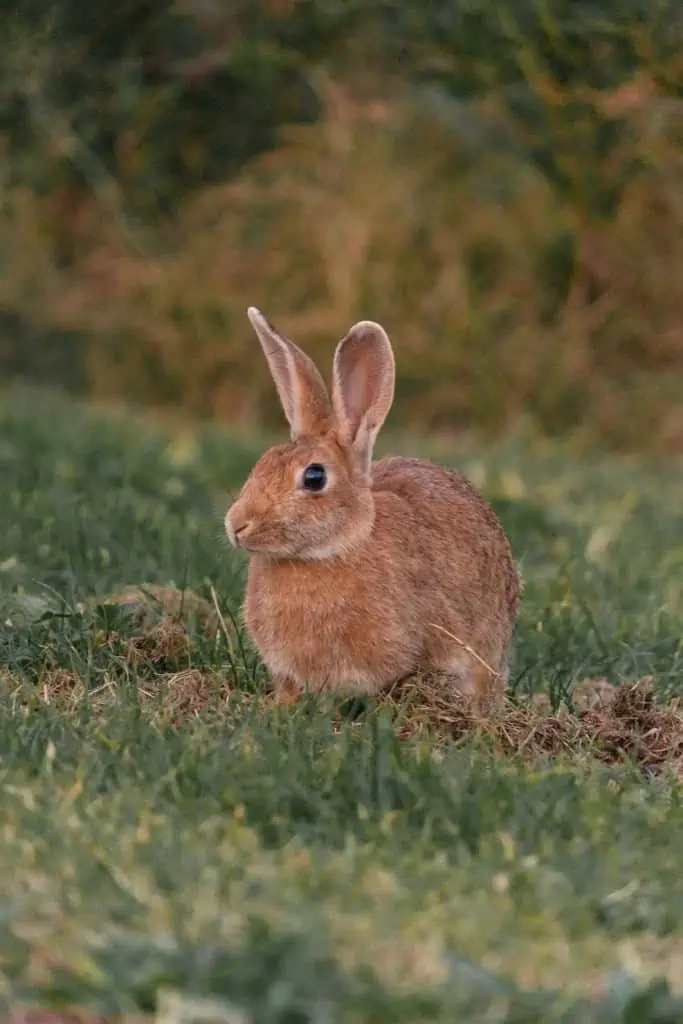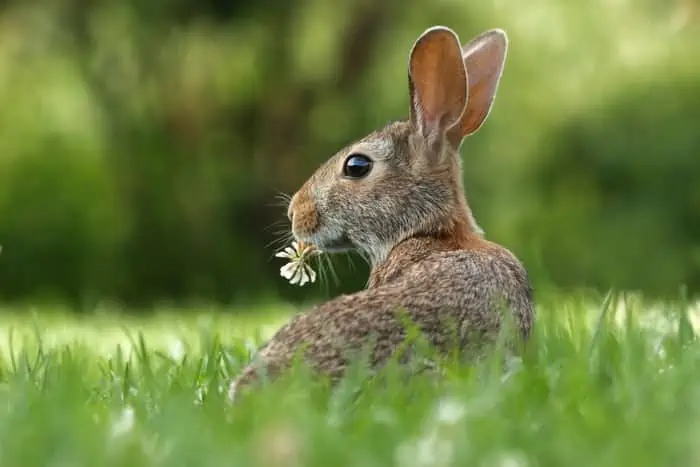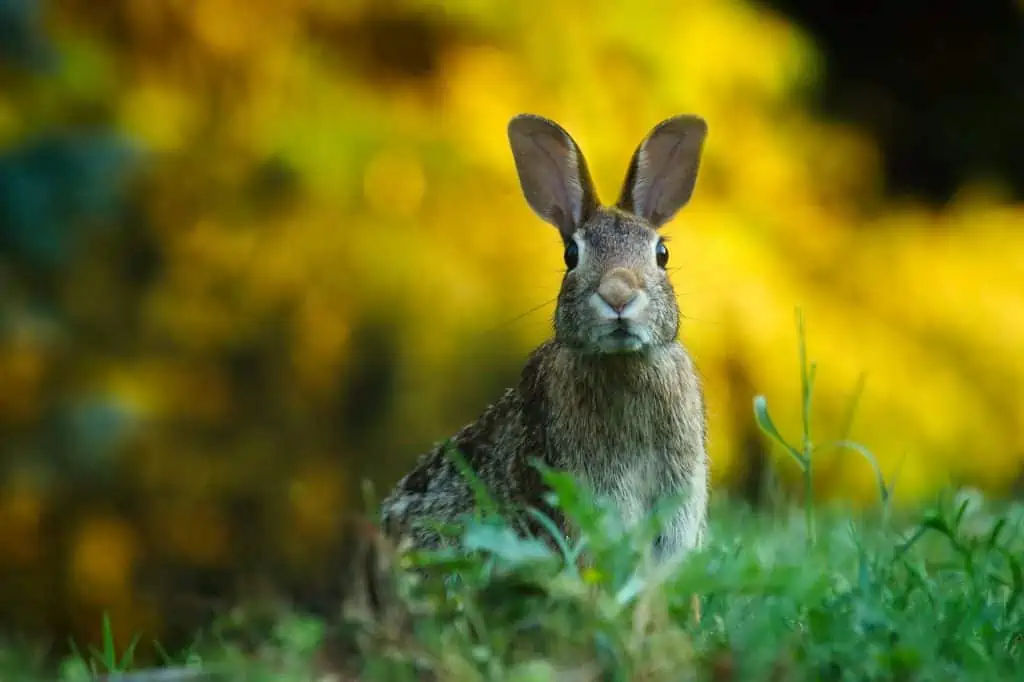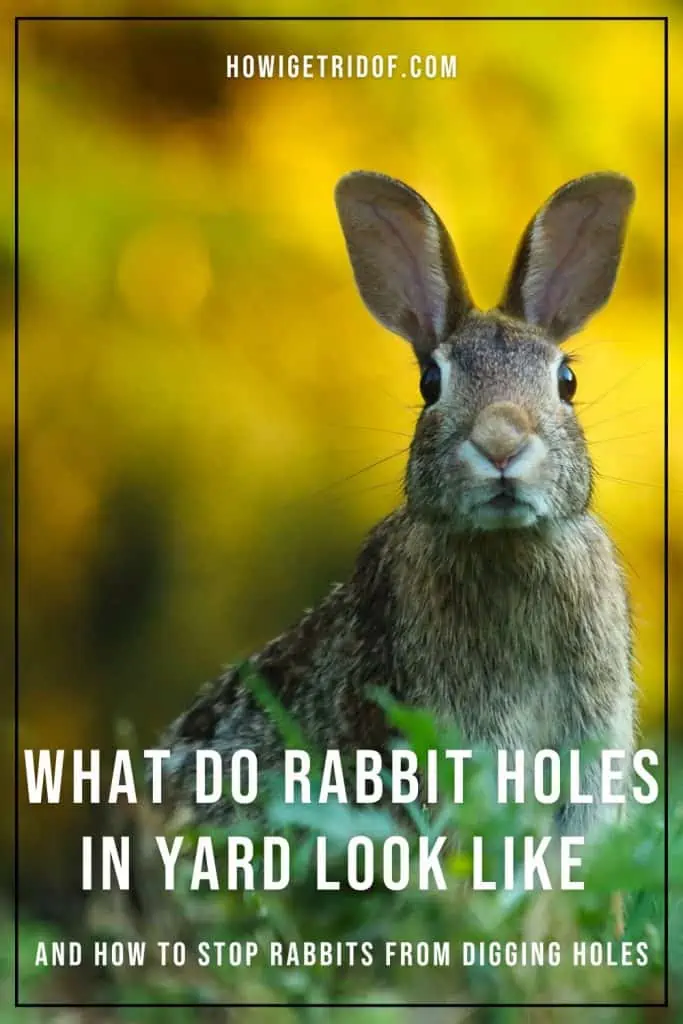Rabbit holes in your yard are not only unsightly, but they can also be dangerous for children, pets, and even your foundation. If you want to stop rabbits from digging holes in yard, there are some things you can do to discourage them from digging.
But before we talk about how to discourage rabbits from digging holes in yard, let’s first talk a bit about rabbits. Keep reading.
Contents
Rabbits – The Cute, The Not-So-Cute, And The Destructive
Wild rabbit holes can cause destruction on your property and in your garden.
Wild rabbits are everywhere. They’re in your garden, they’re in your backyard and they’re even in your walls. They’re cute, they’re fluffy and they have no qualms about chewing through the wiring in your house.
Many wild rabbits are considered to be pests – but why? Let’s take a look at the life cycle of the wild rabbit, how it differs from its domestic counterpart and how you can deal with them.
Wild rabbits can be cute, but they can also be destructive, particularly when they live in large numbers and are digging rabbit holes in yards.
Rabbits are a type of lagomorph. Lagomorphs are mammals that have two pairs of upper incisors instead of just one pair like most other mammals. These incisors grow continuously throughout their lives, so the animals need to nibble on hard objects such as wood or straw to wear them down and keep them trim.
These animals are known to live in many parts of the world, including North America and Europe. They tend to inhabit wooded areas where there is plenty of food available for them to eat. Some species of rabbits live in deserts or grasslands rather than forests, but they still prefer areas with plenty of shade and cover from predators such as birds of prey, foxes, wolves, or coyotes.
Rabbits have one of the fastest reproduction cycles among mammals, producing five to seven litters per year with as many as eight kits in each litter. The gestation period for a rabbit is just over a month, so they can produce a new litter within two months of giving birth to their last litter. A doe can become pregnant again immediately after giving birth.
The gestation period is 28 days and females are capable of having two kinds of milk: one rich in fat for newborns and another thinner milk for older offspring. Rabbits are born hairless and blind and weigh only about an ounce at birth. As they grow, they become increasingly more independent from their mothers until they reach sexual maturity at about two months old when they leave their mother’s burrow permanently to find their own territories.
While this is amazing, it is also one of the reasons rabbits can be so destructive.
For the most part, one or two rabbits digging rabbit holes in the yard is not going to be a major issue. However, several rabbits digging rabbit holes in yard can be seriously problematic and destructive not only to your garden but also to your foundation and the land around your property.
Rabbit Holes In Yard – Signs To Look For
Rabbits are often the first indicator that you might wind up with rabbit holes.
Domesticated rabbits are often seen as cute, furry creatures that make cuddly pets. However, wild rabbits can be destructive pests that ruin your lawn and garden, as we discussed above. If you’re seeing damage from rabbits in your yard, it’s important to know what rabbit holes look like and how to identify them so you can treat rabbit holes in yard once and for all.
Rabbit Holes In Yard – Signs To Look For
Rabbits are known for their burrowing habits, so it’s not uncommon to find rabbit holes in your yard. They can be a nuisance because they dig up plants and make holes in yards, sidewalks, and driveways. But rabbit holes aren’t just unsightly — they can also be dangerous if you step into one and hurt yourself.
Rabbits dig burrows in the ground for shelter and protection. These burrows can be up to two feet deep and two feet wide, depending on how big the rabbit is. The entrance to the burrow will be a round hole that is two inches wide.
These holes can appear anywhere in your yard but they are most visible near trees or shrubs because of the thick cover provided by these plants that can offer protection to rabbits from predators.
How To Identify Rabbit Holes
The best way to identify rabbit holes in your yard is by looking for clues like chewed bark on trees or shrubs, droppings, and torn-up plants. You might also notice grass growing over their burrows or gnawed bark on trees or shrubs.
Other signs of rabbits aside from rabbit holes in yard include rabbit droppings, which look similar to rabbit pellets with pointed ends, but they are larger than squirrel droppings and have larger seeds mixed in them.
Gnawed bark could be another sign of rabbits on your property. You may notice gnawed bark on trees or shrubs that indicate rabbits may be nearby. Rabbits need the nutrients from the tree’s bark and will also chew to help grind down their teeth. However, squirrels also chew bark so be sure you are keeping an eye out for other signs of rabbits in your yard before determining the source of the issue and treating it.
Another sure sign of rabbit holes in yard issues is sightings of rabbits themselves. These animals can be shy of humans, but remember they are also rapid reproducers and often have a ravenous appetite. If you have a number of rabbit holes in yard issues cropping up, chances are you will also begin seeing plenty of rabbits hopping about in your garden before long.
Why Do I Have Rabbits Digging Rabbit Holes In Yard?
Rabbits dig holes for a few reasons, but most often to protect their young and keep themselves safe from predators.
Along with reproducing, rabbits are famous for their digging and burrowing. They are attracted to areas that have loose dirt and are able to dig holes freely. Rabbits dig holes for two reasons: they dig either to create a nest for their young or they dig for shelter and protection from predators.
Rabbits make two kinds of burrows, as we mentioned, known as either temporary warrens or permanent burrows.
Temporary warrens are made for breeding and are where rabbits will give birth to baby rabbits. These burrows are usually found near gardens and fields where there is plenty of food for the rabbits to eat. The nest is lined with fur from the rabbit’s belly and contains one or more baby rabbits. The adults do not stay in the nest while they are raising their young, but they will return often to feed them.
Permanent burrows have one main entrance but many exits leading to different paths within the tunnel system. Rabbits use this tunnel system as a place to sleep, hide from predators and store extra food for the winter months when plants are scarce.
Besides digging rabbit holes in yard issues, rabbits can also cause damage by eating plants, flowers, shrubs, and trees in your yard or garden. This can be a problem if you have plants that you want to grow or if you have flowers that you want to keep around for aesthetic purposes. You may also find your lawn covered with rabbit droppings throughout the day when they eat grasses or weeds in your yard, and this can be hazardous to your health and the health of your pets.
Rabbits are herbivores that eat grass and plants. They are not known to be aggressive animals and will only bite if provoked or threatened. Although wild rabbits are not aggressive, they do carry diseases that can be transmitted to humans through bites or scratches from an infected animal. The most common rabbit-borne diseases include ringworm, pasteurellosis, mycobacteriosis, external parasites, and cryptosporidiosis.
But how do you keep rabbits out of your yard and stop them from digging rabbit holes in yard? Well, the best way to do this is to understand why they are attracted to your yard in the first place.
Tips For Keeping Rabbits From Digging Rabbit Holes In Yard
Making your yard less hospitable to rabbits can help keep holes at bay.
Wild rabbits may appear in your yard because you’re unwittingly providing food for them or because there’s an opening in your fence where they can get in. Rabbits prefer open ground for foraging at night when it’s cooler, so they may be attracted to your yard if you have large areas of grass or weeds with little cover.
You can make your yard less attractive to rabbits by removing any vegetation that will provide cover or food. Trim back any overgrown bushes that are close to your home or property line, and clear brush away from fences and other structures that might provide access points for rabbits.
Rabbits also need water, so make sure there’s not an easily accessible source of fresh water for them (and other wildlife) near your house.
You can also help keep rabbits and rabbit holes in yard at bay by using the below methods:
Use repellents: You can use sprays or granules that contain natural ingredients such as garlic, ammonia, or cayenne pepper. This will deter rabbits from coming into your garden. However, make sure that you spray these repellents away from plants so that they do not harm them.
Use catch and release traps: You can set these traps near holes or other places where you have seen rabbits before. Once the rabbit is caught, you can release it far away from your property. This method may not work well for long-term solutions but it does remove the current problem for a short time until another rabbit takes its place
Use fencing: A rabbit-proof fence is one of the most effective and humane ways to go about keeping rabbits from digging holes in your yard. You can use a wire mesh fence with 1/2-inch openings or a wooden slat fence with no more than 1/4-inch openings to keep these animals out of areas you don’t want them digging.
Call a professional pest control expert: If you are unable to fence off an area, you may want to call a professional pest control expert who uses poison baits or traps to kill the rabbits that are causing problems in your yard. This method is not always safe for children or pets, but it will work if there is no other option available.
Use home remedies: Some people choose to use home remedies like mothballs or blood meal to deter rabbit holes in yard issues, but these methods may not work as effectively on their own and are often most successful when used in conjunction with other methods of removal. Of course, if you’re interested in using home remedies to stop rabbit holes in yard issues, scroll down. We have a section dedicated below just for you.
Otherwise, keep reading to look at some of the best products we recommend for reducing rabbit holes in yard issues.
Best Products For Stopping Rabbit Holes In Yard
Rabbit-proof fences and repellents can help keep rabbit holes from occurring.
The best way to prevent rabbits from coming into your yard is to block the holes they use to get into your yard. This can be done by blocking all their entry points or by installing wire mesh around areas you want to protect, as we mentioned above. Another way to reduce rabbit holes in yard issues is by investing in repellents and products to keep rabbits at bay.
Below is a list of some of our favorite products we recommend for stopping rabbit holes in yard issues once and for all.
Liquid Fence Deer and Rabbit Repellent Concentrate
No products found.
Liquid Fence Deer and Rabbit Repellent Concentrate is one of the most effective products on the market for repelling rabbits and other pests. The spray is made from natural ingredients that are safe for humans, animals, plants, and even children. This product has been proven as an effective way to keep rabbits off of your property.
The Liquid Fence Deer and Rabbit Repellent Concentrate comes in an easy-to-use spray bottle that allows you to easily apply the repellent where needed. The spray works best when sprayed directly onto plants that are susceptible to rabbit damage, such as shrubs or trees. You should not spray it directly on any surface that may be damaged by water (such as wood).
Petoor Store Ultrasonic Animal Repeller
No products found.
The Petoor Store ultrasonic animal repeller is an electronic device that produces ultrasonic sounds, which are inaudible to humans but can be heard by animals such as cats and dogs. The device uses high-frequency sound waves that irritate the ears of animals, causing them to leave the area.
The product works by emitting high-frequency sound waves that irritate the ears of rabbits. The only difference between this product and similar devices is that it emits high-frequency noise instead of regular low-frequency noise.
The Petoor Store ultrasonic animal repeller is designed with a speaker that produces a frequency between 20 kHz and 45 kHz, which is beyond the range of human hearing but within the range of some animals such as rabbits, rats, and mice.
Bonide Repels-All Animal Repellent Granules
No products found.
Bonide Repels-All Animal Repellent Granules is an all-natural, non-toxic, and environmentally friendly way to keep pests away.
The granules are made with a natural active ingredient that is derived from cinnamon oil. This granule can be used in the garden, around your home, or on your lawn. It will not harm children, pets, or plants when used as directed.
This product works on many different pests including rabbits, rodents, ants, cockroaches, fleas, and ticks. The Bonide Repels-All Animal Repellent Granules can be applied by hand or using a spreader that attaches to your garden hose.
Plantskydd Animal Repellent Spray
No products found.
The Plantskydd Animal Repellent Spray is a great option for repelling rabbits from your yard and keeping them from digging holes. This product works when sprayed directly onto the leaves of the plants, which creates an unpleasant taste in the rabbit’s mouth when it eats the plant.
This product is safe for all types of plants, including vegetables, fruit trees, and flowers. It’s also safe around children and pets because it’s made from all-natural ingredients like peppermint oil and orange peel extract. You can apply one application up to four times per year without harming your plants or soil.
Best Products You Can Use To Get Rid Of Current Rabbits
If you’re dealing with rabbits in your yard now, you might consider traps to get rid of them.
Rabbits are a common problem for many homeowners. They dig holes in the yard, eat plants and vegetables, and leave droppings around the property. These little furry creatures can cause a lot of damage to your yard and garden.
If you want to stop rabbits from digging holes in the yard, there are several things you can do along with using repellents. If you already have rabbits causing problems, you might consider investing in traps to remove rabbits and then installing a fence. Some of the best catch and release traps for rabbits are listed below.
PULOMI Collapsible Humane Live Animal Trap
No products found.
The PULOMI Collapsible Humane Live Animal Trap is a humane, reusable humane live animal trap that is easy to use and set up. The trap is ideal for trapping small animals such as rats, mice, squirrels, chipmunks, gophers, and groundhogs, and it can be used indoors or outdoors and comes with a carry bag for easy storage.
We like that it features a large trigger plate that can be adjusted to fit smaller animals such as rabbits and squirrels. The trigger plate on the trap is made from durable carbon steel that can last for years when properly cared for to help assist in controlling the rabbits in your yard in the future.
HomeGarden Live Animal Trap
No products found.
If you have a problem with rabbits in your garden, you can use a HomeGarden Live Animal Trap to catch and remove them.
The HomeGarden Live Animal Trap is easy to use, and it can be used to catch any small animal such as a rabbit, gopher, or squirrel that comes into contact with it.
The trap features an easy-to-remove bait box that you can fill with food or other treats that will attract the animal that you want to catch. Once an animal has been caught in this trap, you can release them by opening up the door and sliding out the entire cage without having to touch them at all.
Havahart Catch And Release Animal Trap
No products found.
’Another effective way to get rid of rabbits is to use a Havahart Catch And Release Animal Trap. This device is specifically designed to catch rabbits and release them unharmed back into the wild. The device is humane and provides a safe way to get rid of rabbits in your yard.
The device comes with two doors: one on the top and one on the bottom. It also has two sets of locking door latches, so you can set it up for either the top or bottom entrance. The trap comes with a carrying handle for easy transport and setup.
Home Remedies To Stop Rabbit Holes In Yard
Home remedies like companion planting can help keep rabbits away from your yard.
Rabbits have an insatiable appetite for fresh greens and other types of plants. They will eat almost any type of vegetation, including vegetables, fruit trees, grasses, and flower bulbs. They also love to burrow into your garden beds and eat the roots of your plants.
Luckily, there are several home remedies and methods that can keep rabbits away from your yard. Below are some of our favorite home remedies for preventing rabbit holes in yard issues.
Make Your Own Cayenne Pepper Spray
You can make your own cayenne pepper spray or buy it in a ready-to-use formula. The spray can be used on plants, on the ground, and around the perimeter of your yard or garden. It’s best to use cayenne pepper in the morning or evening when rabbits are most active. Spray the area where you’ve seen rabbits digging or nibbling plants.
To make a homemade cayenne pepper spray to repel rabbits, you will need:
- Cayenne pepper (2 tablespoons)
- Vinegar (1/2 cup)
- Vegetable oil (1/4 cup)
- Water (1/2 cup)
- One Spray Bottle
Combine the ingredients into the spray bottle and shake until the solution is mixed. Then pray this solution around plants and areas you have noticed rabbit activity.
Rabbits don’t like spicy foods, so they’ll avoid any area sprinkled with cayenne pepper. They may also avoid objects that have been treated with this herbicide. Be aware that cayenne pepper isn’t a long-term solution for keeping rabbits away from your property, however, and this method is best used in conjunction with other methods for rabbit control.
Try Companion Planting
Plant marigolds around your garden perimeter. These flowers are supposed to repel pests such as whiteflies, Japanese beetles, aphids, squash bugs, and mites — just about everything except tomatoes!
Other plants that repel rabbits include peppermint, onions, garlic, chives, and spicy peppers.
Use Essential Oils To Deter Rabbits
There are several essential oils that make a great rabbit repellent, but two of the best include citronella oil and peppermint oil.
Citronella Oil: Citronella oil is extracted from lemongrass, which can be found in the yard and garden section of local nurseries or stores. It’s also used in many types of candles and sprays to keep bugs away. Citronella oil is an effective repellent against rabbits, but it doesn’t last very long so you will need to apply it often. To get the most out of it as a repellent, mix two parts of water with one part of citronella oil and spray it every two weeks or so around the perimeter of your yard.
Peppermint Oil: Peppermint oil is another good choice if you’re looking for an all-natural way to keep rabbits away from your yard. You can add one or two drops of peppermint oil directly to your garden or add some drops to water in a spray bottle when you’re watering your plants. This will help prevent rabbits and even other plant-eating pests from nibbling at your plants.
Rabbit Holes In Yard – Let’s Sum it Up!
Rabbits reproduce quickly. You can manage to control them using the steps listed in this article.
The most common reason for rabbit holes in yard is that there are rabbits living in the area. Rabbits are clever animals and they can burrow into the ground to escape predators. They dig their own burrows and create one or more tunnels within a network of interconnected burrows which they use for shelter and protection from predators.
These tunnels may also serve as a food storage space or nesting area. Rabbits will often use their burrows as an escape route when frightened by something nearby, be it human or animal.
There are several ways to prevent your lawn from turning into an ugly mess of rabbit holes. Along with using the tips and products above, you can also help keep rabbits at bay by ensuring your yard is less attractive to these pests.
- Don’t feed wild rabbits
- Use bird netting around tender plants
- Seal off entrances to your house
- Use repellents such as ammonia or cayenne pepper, which can be sprinkled around plant beds to repel rabbits
- Use a rabbit-proof fence around your home or yard
- Invite the predators to keep rabbits at bay
- Contact a professional if you notice rabbits are getting out of hand
If you have tried everything else and you’re still having trouble with rabbits, then you may want to consider hiring a professional pest control expert. This is especially true if you have a large yard that is impossible for you to keep an eye on at all times.
A professional pest control expert will know how to get rid of rabbits using the best and most effective methods possible.
We hope this has been a helpful guide on rabbit holes in yard issues. Remember, while rabbits can be fun and pleasant to watch in your yard, too many rabbits can quickly cause damage.
It’s best to control and monitor them in your yard to ensure you can enjoy your garden rabbit-free for years to come.
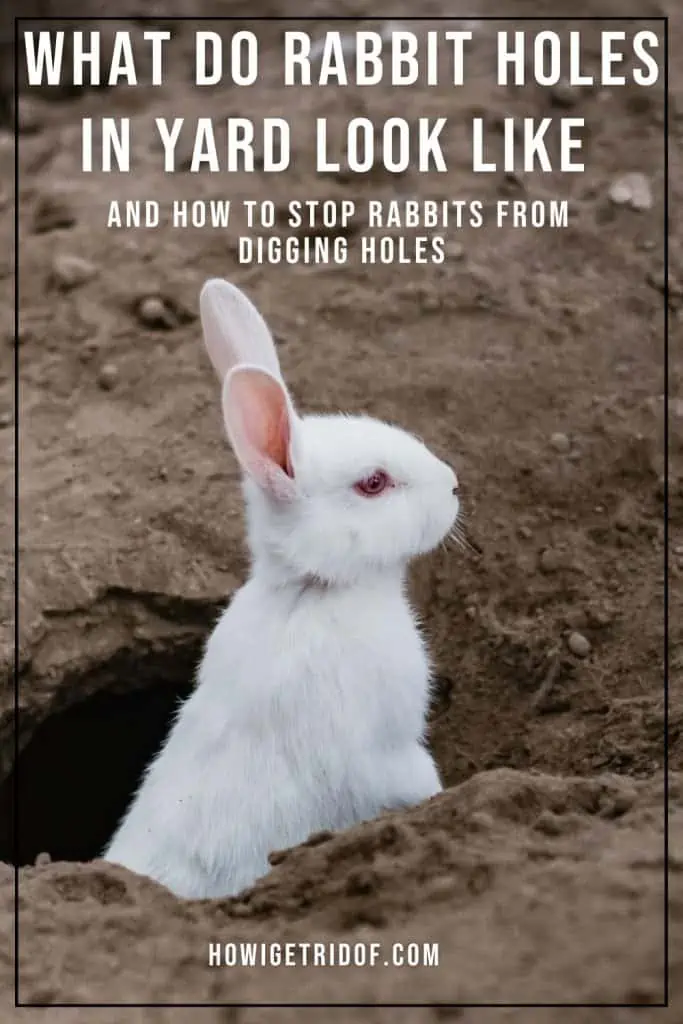

Jack founded our blog after two decades of working in the pest control industry. His vast experience dealing with a wide array of pests allows him to diagnose issues quickly and get to the heart of pest problems quickly and effectively. He has serviced more than 2,000 homes over his career and there is hardly any pest situation that he has not seen before.
